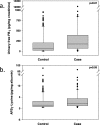Mycotoxin exposure is associated with increased risk of esophageal squamous cell carcinoma in Huaian area, China
- PMID: 31842816
- PMCID: PMC6916103
- DOI: 10.1186/s12885-019-6439-x
Mycotoxin exposure is associated with increased risk of esophageal squamous cell carcinoma in Huaian area, China
Abstract
Background: Consumption of moldy food has previously been identified as a risk factor for esophageal squamous cell carcinoma (ESCC) in high-risk countries; however, what contributing roles these dietary carcinogenic mycotoxins play in the etiology of ESCC are largely unknown.
Methods: A mycotoxin biomarker-incorporated, population-based case-control study was performed in Huaian area, Jiangsu Province, one of the two high-risk areas in China. Exposure biomarkers of aflatoxins (AF) and fumonisins (FN) were quantitatively analyzed using HPLC-fluorescence techniques.
Results: Among the cases (n = 190), the median levels of AF biomarker, serum AFB1-lysine adduct, and FN biomarker, urinary FB1, were 1.77 pg/mg albumin and 176.13 pg/mg creatinine, respectively. Among the controls (n = 380), the median levels of AFB1-lysine adduct and urinary FB1 were 1.49 pg/mg albumin and 56.92 pg/mg creatinine, respectively. These mycotoxin exposure biomarker levels were significantly higher in cases as compared to controls (p < 0.05 and 0.01, respectively). An increased risk to ESCC was associated with exposure to both AFB1 and FB1 (p < 0.001 for both).
Conclusions: Mycotoxin exposure, especially to AFB1 and FB1, was associated with the risk of ESCC, and a greater-than-additive interaction between co-exposures to these two mycotoxins may contribute to the increased risk of ESCC in Huaian area, China.
Keywords: Aflatoxin B1; Co-exposure; Esophageal cancer; Fumonisin B1; Molecular epidemiology; Mycotoxins.
Conflict of interest statement
The authors declare that they have no competing interests.
Figures


Similar articles
-
Association of anthropometric indicators with oesophageal squamous carcinoma and precancerous lesions in people aged 40-69 years from high-risk setting in China: a population-based study.BMJ Open. 2025 Jul 28;15(7):e087639. doi: 10.1136/bmjopen-2024-087639. BMJ Open. 2025. PMID: 40730401 Free PMC article.
-
Biomarker-based evaluation of aflatoxin B1 exposure in cattle.Vet World. 2025 May;18(5):1297-1305. doi: 10.14202/vetworld.2025.1297-1305. Epub 2025 May 25. Vet World. 2025. PMID: 40584113 Free PMC article.
-
Urinary biomarker-based seasonal mycotoxin exposure assessment in rural resident populations of North-central Nigeria.Environ Int. 2025 Aug 6;203:109713. doi: 10.1016/j.envint.2025.109713. Online ahead of print. Environ Int. 2025. PMID: 40818154
-
The Black Book of Psychotropic Dosing and Monitoring.Psychopharmacol Bull. 2024 Jul 8;54(3):8-59. Psychopharmacol Bull. 2024. PMID: 38993656 Free PMC article. Review.
-
Facial flushing response to alcohol and the risk of esophageal squamous cell carcinoma: A comprehensive systematic review and meta-analysis.Cancer Epidemiol. 2016 Feb;40:31-8. doi: 10.1016/j.canep.2015.10.011. Epub 2015 Nov 24. Cancer Epidemiol. 2016. PMID: 26618333
Cited by
-
Shifting the center of gravity for addressing the rising cancer disease burden in Africa: A rationale for African-based integrative infectious diseases and oncology research.PLOS Glob Public Health. 2023 May 31;3(5):e0001970. doi: 10.1371/journal.pgph.0001970. eCollection 2023. PLOS Glob Public Health. 2023. PMID: 37256858 Free PMC article. No abstract available.
-
Sphingolipid Effects on the Plasma Membrane Produced by Addition of Fumonisin B1 to Maize Embryos.Plants (Basel). 2020 Jan 23;9(2):150. doi: 10.3390/plants9020150. Plants (Basel). 2020. PMID: 31979343 Free PMC article.
-
Research Progress on Fumonisin B1 Contamination and Toxicity: A Review.Molecules. 2021 Aug 29;26(17):5238. doi: 10.3390/molecules26175238. Molecules. 2021. PMID: 34500671 Free PMC article. Review.
-
Overview of Risk Factors for Esophageal Squamous Cell Carcinoma in China.Cancers (Basel). 2023 Nov 27;15(23):5604. doi: 10.3390/cancers15235604. Cancers (Basel). 2023. PMID: 38067307 Free PMC article. Review.
-
Evaluation of aflatoxin and fumonisin co-exposure in urine samples from healthy volunteers in northern Mexico.Toxicol Rep. 2021 Oct 4;8:1734-1741. doi: 10.1016/j.toxrep.2021.10.001. eCollection 2021. Toxicol Rep. 2021. PMID: 34692424 Free PMC article.
References
-
- American Cancer Society . Global Cancer Facts & Figures. 3. Atlanta: American Cancer Society; 2015.
-
- Kamangar F, Malekzadeh R, Dawsey SM, Saidi F. Esophageal cancer in northeastern Iran: a review. Arch Iran Med. 2007;10(1):70–82. - PubMed
MeSH terms
Substances
Grants and funding
LinkOut - more resources
Full Text Sources
Medical
Miscellaneous

